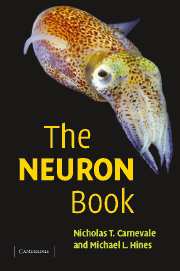Book contents
- Frontmatter
- Contents
- Preface
- Acknowledgments
- 1 A tour of the NEURON simulation environment
- 2 The modeling perspective
- 3 Expressing conceptual models in mathematical terms
- 4 Essentials of numerical methods for neural modeling
- 5 Representing neurons with a digital computer
- 6 How to build and use models of individual cells
- 7 How to control simulations
- 8 How to initialize simulations
- 9 How to expand NEURON's library of mechanisms
- 10 Synaptic transmission and artificial spiking cells
- 11 Modeling networks
- 12 hoc, NEURON's interpreter
- 13 Object-oriented programming
- 14 How to modify NEURON itself
- Appendix A1 Mathematical analysis of IntFire4
- Appendix A2 NEURON's built-in editor
- Epilogue
- Index
1 - A tour of the NEURON simulation environment
Published online by Cambridge University Press: 01 September 2010
- Frontmatter
- Contents
- Preface
- Acknowledgments
- 1 A tour of the NEURON simulation environment
- 2 The modeling perspective
- 3 Expressing conceptual models in mathematical terms
- 4 Essentials of numerical methods for neural modeling
- 5 Representing neurons with a digital computer
- 6 How to build and use models of individual cells
- 7 How to control simulations
- 8 How to initialize simulations
- 9 How to expand NEURON's library of mechanisms
- 10 Synaptic transmission and artificial spiking cells
- 11 Modeling networks
- 12 hoc, NEURON's interpreter
- 13 Object-oriented programming
- 14 How to modify NEURON itself
- Appendix A1 Mathematical analysis of IntFire4
- Appendix A2 NEURON's built-in editor
- Epilogue
- Index
Summary
… so, entering, the first thing I did was to stumble over an ash-box in the porch. Ha! thought I, ha, as the flying particles almost choked me, are these ashes from that destroyed city, Gomorrah?
Modeling and understanding
Modeling can have many uses, but its principal benefit is to improve understanding. The chief question that it addresses is whether what is known about a system can account for the behavior of the system. An indispensable step in modeling is to postulate a conceptual model that expresses what we know, or think we know, about a system, while omitting unnecessary details. This requires considerable judgment and is always vulnerable to hindsight and revision, but it is important to keep things as simple as possible. The choice of what to include and what to leave out depends strongly on the hypothesis that we are studying. The issue of how to make such decisions is outside the primary focus of this book, although from time to time we may return to it briefly.
The task of building a computational model should only begin after a conceptual model has been proposed. In building a computational model we struggle to establish a match between the conceptual model and its computational representation, always asking the question: would the conceptual model behave like the simulation? If not, where are the errors? If so, how can we use NEURON to help understand why the conceptual model implies that behavior?
Introducing NEURON
NEURON is a simulation environment for models of individual neurons and networks of neurons that are closely linked to experimental data.
- Type
- Chapter
- Information
- The NEURON Book , pp. 1 - 31Publisher: Cambridge University PressPrint publication year: 2006
- 2
- Cited by

